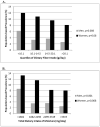Association of low dietary intake of fiber and liquids with constipation: evidence from the National Health and Nutrition Examination Survey
- PMID: 23567352
- PMCID: PMC3786707
- DOI: 10.1038/ajg.2013.73
Association of low dietary intake of fiber and liquids with constipation: evidence from the National Health and Nutrition Examination Survey
Abstract
Objectives: Epidemiological studies support an association of self-defined constipation with fiber and physical activity, but not liquid intake. The aims of this study were to assess the prevalence and associations of dietary fiber and liquid intake to constipation.
Methods: Analyses were based on data from 10,914 adults (≥20 years) from the 2005-2008 cycles of the National Health and Nutrition Examination Surveys. Constipation was defined as hard or lumpy stools (Bristol Stool Scale type 1 or 2) as the "usual or most common stool type." Dietary fiber and liquid intake from total moisture content were obtained from dietary recall. Co-variables included: age, race, education, poverty income ratio, body mass index, self-reported general health status, chronic illnesses, and physical activity. Prevalence estimates and prevalence odds ratios (POR) were analyzed in adjusted multivariable models using appropriate sampling weights.
Results: Overall, 9,373 (85.9%) adults (4,787 women and 4,586 men) had complete stool consistency and dietary data. Constipation rates were 10.2% (95% confidence interval (CI): 9.6, 10.9) for women and 4.0% (95% CI: 3.2, 5.0) for men (P<.001). After multivariable adjustment, low liquid consumption remained a predictor of constipation among women (POR: 1.3, 95% CI: 1.0, 1.6) and men (POR: 2.4, 95% CI: 1.5, 3.9); however, dietary fiber was not a predictor. Among women, African-American race/ethnicity (POR: 1.4, 95% CI: 1.0, 1.9), being obese (POR: 0.7, 95% CI: 0.5,0.9), and having a higher education level (POR: 0.8, 95% CI: 0.7, 0.9) were significantly associated with constipation.
Conclusions: The findings support clinical recommendations to treat constipation with increased liquid, but not fiber or exercise.
Conflict of interest statement
The author acting as the submission’s guarantor must be identified. The submission’s guarantor is Alayne D. Markland, DO, MSc.
The authors must certify the role that each author had in conceiving, initiating and writing up the research project.
Declaration of all financial and, if relevant, any editorial assistance received to support the research project and/or preparation of the article.
Identification of any relationships that any author or other entity that provided financial or editorial support may have in potential competing interests to those referenced in the submission.
Figures



References
-
- Suares NC, Ford AC. Prevalence of, and risk factors for, chronic idiopathic constipation in the community: systematic review and meta-analysis. Am J Gastroenterol. 2011 Sep;106(9):1582–1591. quiz 1581, 1592. - PubMed
-
- Choung RS, Locke GR, Schleck CD, Zinsmeister AR, Talley NJ. Cumulative incidence of chronic constipation: a population-based study 1988-2003. Aliment Pharmacol Ther. 2007 Dec;26(11-12):1521–1528. - PubMed
-
- Johanson JK. Chronic constipation: a survey of the patient perspective. Alimentary Pharmacology & Therapeutics. 2007;25(5):599–608. - PubMed
-
- Irvine EJ, Ferrazzi S, Pare P, Thompson WG, Rance L. Health-related quality of life in functional GI disorders: focus on constipation and resource utilization. Am J Gastroenterol. 2002 Aug;97(8):1986–1993. - PubMed
Publication types
MeSH terms
Grants and funding
LinkOut - more resources
Full Text Sources
Other Literature Sources
Medical

